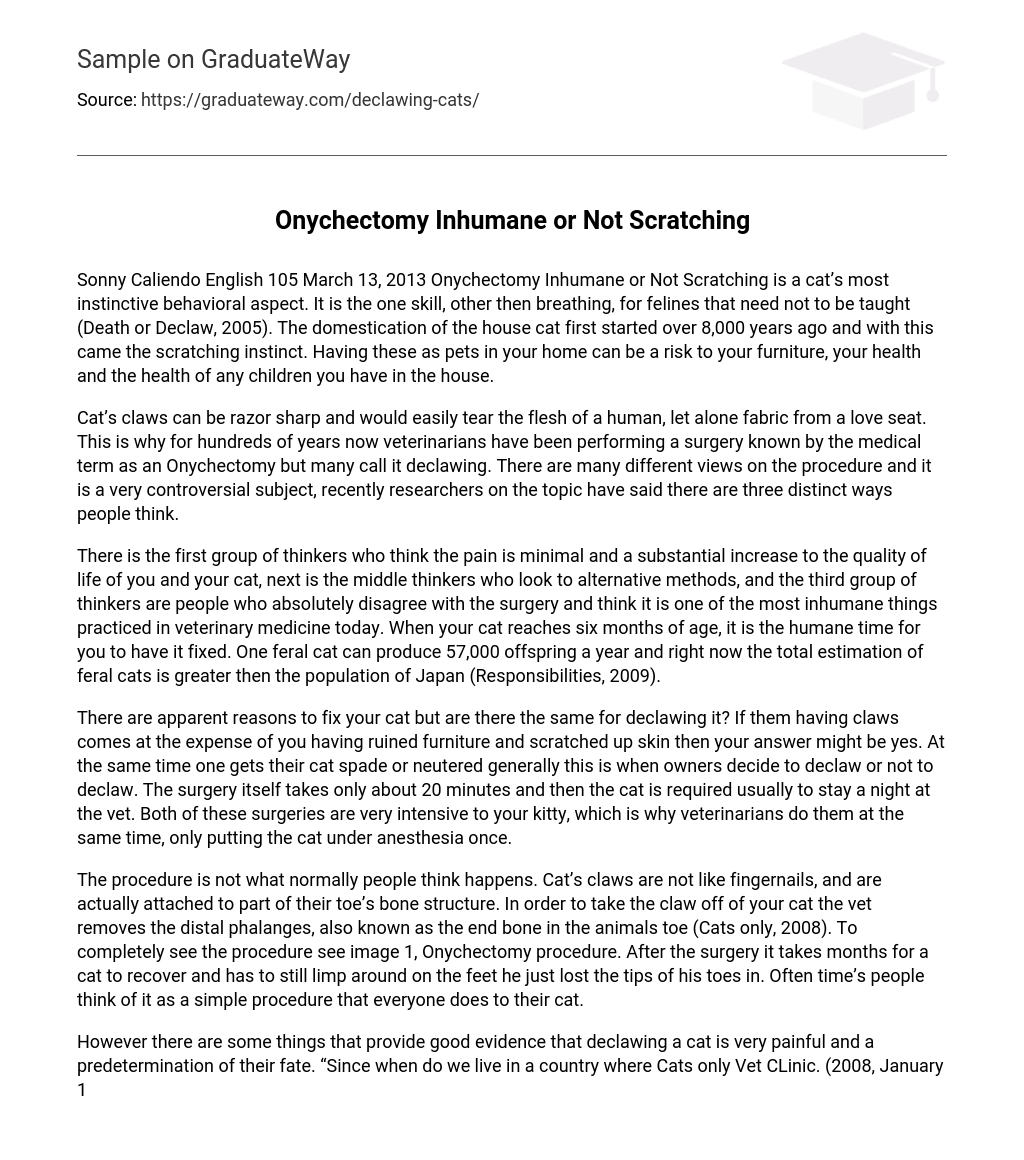Onychectomy is a cat’s most instinctive behavioral aspect. It is the one skill, other then breathing, for felines that need not to be taught (Death or Declaw, 2005). The domestication of the house cat first started over 8,000 years ago and with this came the scratching instinct. Having these as pets in your home can be a risk to your furniture, your health and the health of any children you have in the house.
Cat’s claws can be razor sharp and would easily tear the flesh of a human, let alone fabric from a love seat. This is why for hundreds of years now veterinarians have been performing a surgery known by the medical term as an Onychectomy but many call it declawing. There are many different views on the procedure and it is a very controversial subject, recently researchers on the topic have said there are three distinct ways people think.
There is the first group of thinkers who think the pain is minimal and a substantial increase to the quality of life of you and your cat, next is the middle thinkers who look to alternative methods, and the third group of thinkers are people who absolutely disagree with the surgery and think it is one of the most inhumane things practiced in veterinary medicine today. When your cat reaches six months of age, it is the humane time for you to have it fixed. One feral cat can produce 57,000 offspring a year and right now the total estimation of feral cats is greater then the population of Japan (Responsibilities, 2009).
There are apparent reasons to fix your cat but are there the same for declawing it? If them having claws comes at the expense of you having ruined furniture and scratched up skin then your answer might be yes. At the same time one gets their cat spade or neutered generally this is when owners decide to declaw or not to declaw. The surgery itself takes only about 20 minutes and then the cat is required usually to stay a night at the vet. Both of these surgeries are very intensive to your kitty, which is why veterinarians do them at the same time, only putting the cat under anesthesia once.
The procedure is not what normally people think happens. Cat’s claws are not like fingernails, and are actually attached to part of their toe’s bone structure. In order to take the claw off of your cat the vet removes the distal phalanges, also known as the end bone in the animals toe (Cats only, 2008). To completely see the procedure see image 1, Onychectomy procedure. After the surgery it takes months for a cat to recover and has to still limp around on the feet he just lost the tips of his toes in. Often time’s people think of it as a simple procedure that everyone does to their cat.
The first groups of thinkers targeted are the people who completely agree with declawing and have no problems with it. Their rational is that the surgery for a cat is just like any surgery for a human. However it is not there are many more risks involved and can be very dangerous to the life of your cat and may even lead for it to be euthanized. Plenty of good things can be drawn from declawing but some of the main defenses these group of thinkers use are things like personal safety, destructiveness, and safety of the cat. Sometimes cat owners are on medication for instance blood thinners.
These types of medicines weaken your immune system and turn a little scratch from your cat into a laceration that can easily become infected (Cats n Conflict, 1993). If you simply have a destructive cat that loves to ruin your furniture then your only option may be to declaw it. It is your 5000-dollar furniture or your 100-dollar humane society kitten. Other things to a cat can happen too when dealing with their claws, they can get damage beyond repair from scratching, or fighting, or a infection could form in their claw without them even knowing until it is to late.
This group of thinkers is the most liberal and over the years the size of it has been exponentially decreasing. People are no loner thinking like the first group and thinking more like the second group towards this declawing controversy. Another group of thinkers are people who don’t necessarily disagree with the surgery but instead look for alternatives, as many alternatives as they can before submitting to the Onychectomy after repeated failure. The newest solution to fixing your cats scratching without removing its toes is vinyl caps you actually glue onto your cats claws.
References
- Ginsberg, Susan. “Cats, Claws, And Conflict. ” Animals 126. (1993): 26. MasterFILE Premier. Web. 14 Mar. 2013. “Cat Fight!. ” People 59. 20 (2003): 110. Academic Search Complete. Web. 14 Mar. 2013.
- Atwood-Harvey, D. (2005). Death or Declaw: Dealing with Moral Ambiguity in a Veterinary Hospital. Society & Animals, 13(4), 315-342. doi:10. 1163/156853005774653627
- Whitcomb, R. (2009). Five Calif. cities try to scratch out declawing procedures. DVM: The Newsmagazine Of Veterinary Medicine, 40(12), 6.
- French, Melissa. “Guidelines and Responsibilities. ” Heart of America Humane Society. N. p. , 1 Jan. 2009. Web. 14 Mar. 2013. <http://www. heartofamericahs. org/education/petfacts. php>.





